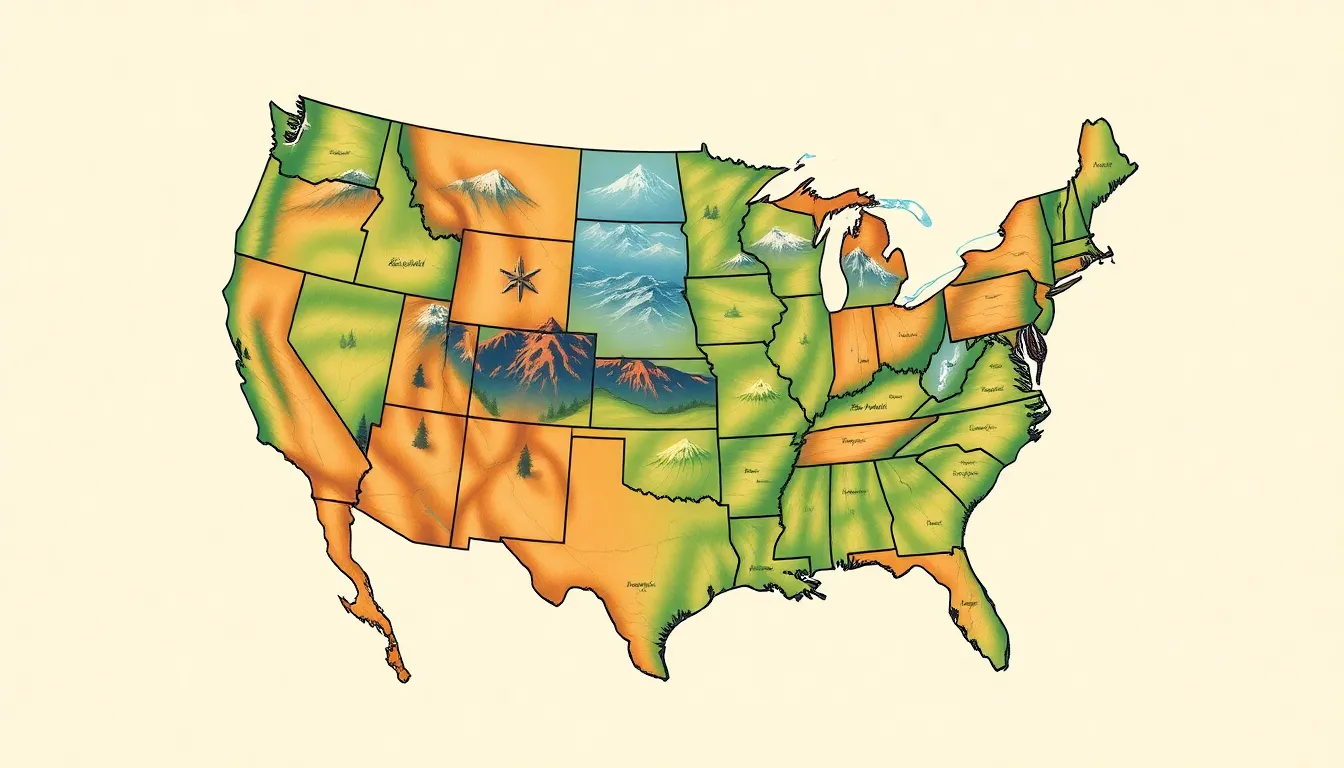Table of Contents
ToggleWhen pondering the great mysteries of geography, one question often pops up: what continent is the United States in? It might seem like a simple inquiry, but it’s a topic that sparks curiosity and, let’s be honest, a few chuckles. After all, who wouldn’t want to impress friends at a trivia night with a fun fact about the land of the free and the home of the brave?
Overview of the United States
The United States is located in North America. This vast country spans over 3.8 million square miles, making it the third-largest nation by area in the world. It shares borders with Canada to the north and Mexico to the south. The United States comprises 50 states, each with unique cultures and geographies.
Population estimates indicate around 331 million people reside in the United States, consisting of diverse ethnic backgrounds. Major cities include New York City, Los Angeles, and Chicago. Each city plays a significant role in the country’s economy and cultural landscape.
Geographical features vary across the U.S. Mountain ranges like the Rockies and the Appalachians create dramatic landscapes. The Great Plains, known for agriculture, juxtapose coastal regions that attract millions of tourists each year.
The United States has a rich history, beginning with Indigenous peoples and evolving through colonization and independence. Founding documents such as the Declaration of Independence and the Constitution lay the groundwork for its democratic system.
Economically, it stands as one of the largest in the world, driven by technology, finance, and manufacturing. Various industries significantly contribute to the GDP, showcasing innovation and growth.
In terms of climate, the U.S. experiences a range from arctic in Alaska to tropical in Hawaii. Seasonal changes influence the daily lives of residents, impacting activities and events throughout the year.
Overall, the continent of North America hosts the United States, offering a blend of diverse landscapes, cultures, and economic opportunities, making it a notable part of the global community.
Understanding Continents

Continents represent the largest landmasses on Earth. Each continent features its own unique environmental, cultural, and political characteristics.
Definition of a Continent
A continent is a continuous expanse of land recognized for geographical, cultural, or historical significance. Seven continents, including Asia, Africa, North America, South America, Antarctica, Europe, and Australia, divide the globe. Size and population vary greatly among these continents. North America, for instance, is the third-largest continent, encompassing over 9.5 million square kilometers and housing diverse nations, including the United States.
Importance of Continents in Geography
Continents play a crucial role in the study of geography. They serve as fundamental units for understanding Earth’s physical features and human activities. By examining continents, one can analyze climate patterns, natural resources, and biodiversity. Each continent contributes to global ecosystems and influences weather systems. Additionally, they facilitate cultural exchanges among nations, enhancing international relations. Understanding continents aids in grasping global demographics and economic distributions, leading to informed decisions in policy and education.
North America: The Continent of the United States
The United States occupies a significant position in North America, bordered by Canada to the north and Mexico to the south. Stretching from the Atlantic Ocean on the east to the Pacific Ocean on the west, its geographical location enhances its accessibility and diversity. Major rivers, including the Mississippi and Missouri, traverse the country, shaping both its landscape and economy. The U.S. also features mountain ranges such as the Rockies and the Appalachians, contributing to its varied climate and ecosystems.
Geographical Location
North America spans approximately 9.5 million square kilometers, making it the third-largest continent. The United States accounts for a substantial portion of this area at about 3.8 million square miles. Its positioning between the Arctic and tropical regions leads to climate variations that range from arctic conditions in Alaska to warmer climates in places like Florida and Hawaii. The continent’s geographical diversity, including deserts, mountains, and plains, creates unique environments and habitats.
Major Characteristics of North America
North America boasts a range of distinct characteristics that affirm its global significance. Economically, it features strong industries in technology, agriculture, and manufacturing, making it a leader in global trade. Culturally, the continent is a tapestry of influences from Indigenous peoples, immigrant communities, and rich historical narratives. Major urban centers like New York, Los Angeles, and Toronto showcase cultural diversity and economic power. Geographically, the U.S. partakes in environmental variety, from coastal areas to mountainous terrains, supporting unique ecosystems and recreational opportunities.
Cultural and Economic Significance
The cultural and economic significance of the United States profoundly impacts both North America and the world.
Cultural Diversity in the United States
Cultural diversity in the United States showcases a tapestry of ethnicities. Over 331 million people contribute unique traditions and practices. Major cities serve as cultural hubs, offering vibrant neighborhoods and events. Each state boasts its own customs, reflecting historical influences and regional characteristics. Annual celebrations like the Fourth of July and Thanksgiving highlight the fusion of traditions. Culinary diversity, from Southern barbecue to New York-style pizza, captures the nation’s rich heritage. This cultural melting pot fosters innovation and creativity across various fields, including art and music. Furthermore, diversity enhances social interactions, promoting understanding and tolerance among different groups.
Economic Impact on North America
Economic impact of the United States extends throughout North America. With a GDP exceeding $21 trillion, the U.S. ranks among the world’s largest economies. Trade relationships with Canada and Mexico contribute significantly to regional economic stability. Numerous industries, such as technology and manufacturing, drive job creation and economic growth. The U.S. is also a leading destination for foreign investment, attracting companies seeking a stable market. Cities like San Francisco and Houston are vital economic engines, hosting numerous corporations and startups. Infrastructure development in transportation and communication further enhances productivity and connectivity. Overall, the economic influence of the United States plays a critical role in shaping North America’s prosperity.
The United States, firmly situated in North America, plays a vital role in the continent’s cultural and economic landscape. Its vast geography and diverse population contribute to a rich tapestry of experiences and opportunities. From bustling cities to breathtaking natural wonders, the U.S. offers a unique perspective on what makes North America special. As discussions about continents arise, the significance of the U.S. within this framework becomes even more apparent, showcasing its influence on global affairs and cultural exchanges. Understanding its position not only enriches geographical knowledge but also highlights the interconnectedness of nations across the globe.



